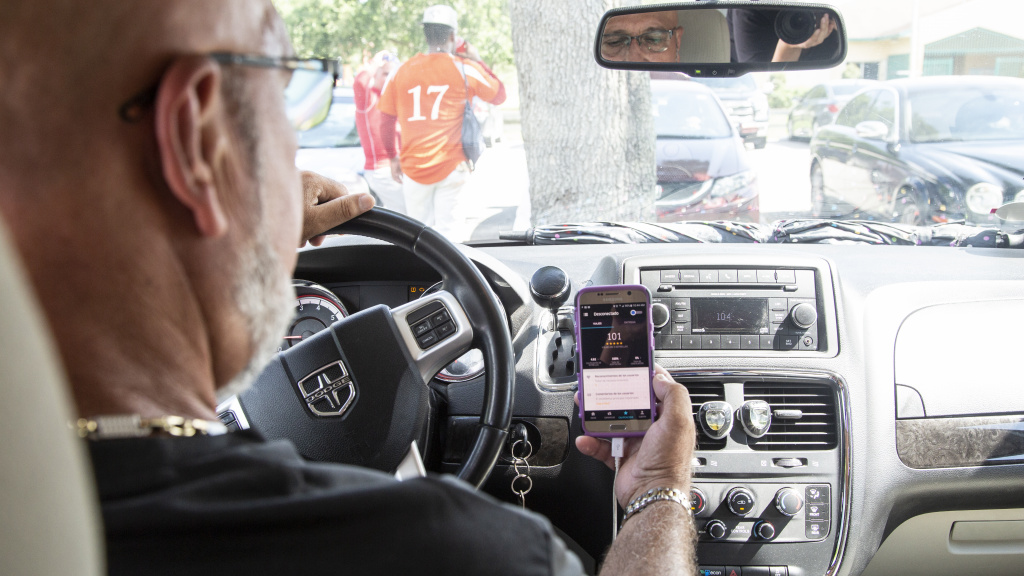Retirement options shrink for South Florida’s senior citizens
Allessandra Inzinna
Palmetto High School
Every Sunday, 62-year-old Luis Orlando-Ricardo finds himself on the softball fields of Tropical Park. It’s his time to decompress after working six days a week as an electrician, and as an Uber and Lyft driver.
“It’s my time to relax,” Orlando-Ricardo said.
A Miami resident of 25 years, he started driving for Uber because of the promise of more money in his pocket and a way out of working as an electrician in the hot sun. Looking to retire this year from his electrician job, Orlando-Ricardo plans to continue with his Lyft and Uber jobs and does not see retirement in his near future.

After an afternoon at the ballpark, Luis Orlando-Ricardo hops in his car to catch Uber and Lyft fares. (Photo by: Chloe-Amelie Aikman)
His situation is not unique. Baby boomers are working longer because of longer life expectancies, changing work demands, and diminishing retirement plans. As a result, the number of people 65 and older who are still working has jumped from four million in 2000 to nine million in 2017.
Even more surprising, the number of people 85 and older who are still working has also skyrocketed from 2.2 percent of the population in the workforce in 2006 to 4.4 percent in 2017.
Teresa Ghilarducci, a labor economist and nationally recognized expert in retirement security, estimates that approximately 60 percent of seniors (people 65 or older) are working due to financial insecurity.
“Inadequate retirement accounts and pensions mean that millions of boomers and younger people will seek work in retirement, desperate to take any job at almost any age,” Ghilarducci said.
Orlando-Ricardo started Uber and Lyft driving after a friend encouraged him to earn additional income with a side job. Now, Orlando-Ricardo drives his Dodge Grand Caravan up and down Miami streets all day, with his gold chain comfortably hung from his neck and a 4.81 star rating under his belt.
But the popularity of ride share jobs has put more drivers behind the wheel, cutting his pay from about $800 per week to just scratching $500 for full-time work.
“It helps to make the extra money to help your family,” Orlando-Ricardo said. But, while he still feels good enough to work, he doesn’t know when he’ll be able to finally retire.
Ghilarducci warns that when people are forced to stay in the labor market because they cannot retire, wages and working conditions erode, affecting elder health and productivity rates.
Not all older workers are like Orlando-Ricardo. Some continue working solely because they love their jobs.
Cheryl Pimento, a 63-year-old retired flight attendant supervisor from Trinidad, managed flight crews for 34 years as she traveled all over the world.
“In that job, you either love it or you hate it, and I loved it,” Pimento said. “It was a beautiful job.”
Her career came to an end when Pimento reached 60, Trinidad’s mandatory retirement age. She then switched to her second career as a saleswoman at the Bloomingdale’s in The Falls shopping center.
“It’s a way to make extra money and a way to continue,” Pimento said. “I always put all my full effort into any job that I do. Once you do that, everything will be positive, and you will enjoy your job.”

Cheryl Pimento, 63, retired from her airline job in Trinidad, then took a second career at Bloomingdale’s as a salesperson. (Photo by: Mariam Vela)
Pimento, now 63, knew she would find another job to fill time. For Bloomingdale’s, she put in her application and got the job after just one interview. She has no plans for retirement in the near future.
“I will keep working until I physically can’t anymore,” Pimento said. “In other words, I just keep going and never give up.”
Pimento’s mentality represents another common narrative for baby boomers in America. According to U.S. News and World Report, 31 percent of people age 50 and older who are working in their retirement age cite their reason as the boredom of a work-free life. Eighteen percent want to feel productive and 15 percent have a job that is enjoyable.
“The rest work for love,” Ghilarducci said. “They enjoy their job and like the pay.”
But despite the older Americans who work because they want to, for many, the retirement system fails to serve aging Americans well. The devastating effects of the 2008 recession on retirement savings across the country left many elder Americans without the option to stop working.
“Many elders would tell you that they lost twice,” Ghildarucci said. “Their 401K plans took a hit when the tech bubble burst in 2001 and again in 2008 with the financial crisis.”
Between 2005 and 2015, the number of elder Americans working jobs with unstable and low-wage jobs jumped 10 percent, according to The New School Retirement Equity Lab. By 2015, 25 percent of older workers were in those insecure jobs.
“The U.S. is in a unique position among rich nations to be able to afford universal adequate pensions,” Ghilarducci said. “But the U.S. is the only rich nation that leans so heavily and clings so strongly to work as the answer to inadequate retirement income security.”
She said that by 2045, 21.7 million elders will be poor or near poor without changes to retirement plans and Social Security benefits.
Whether older Americans work because they love it or because they have to, Labor Department figures show that for every age above 55, individuals are working or looking for work at the highest rates on record.
The reality of older workers is becoming a new normal.